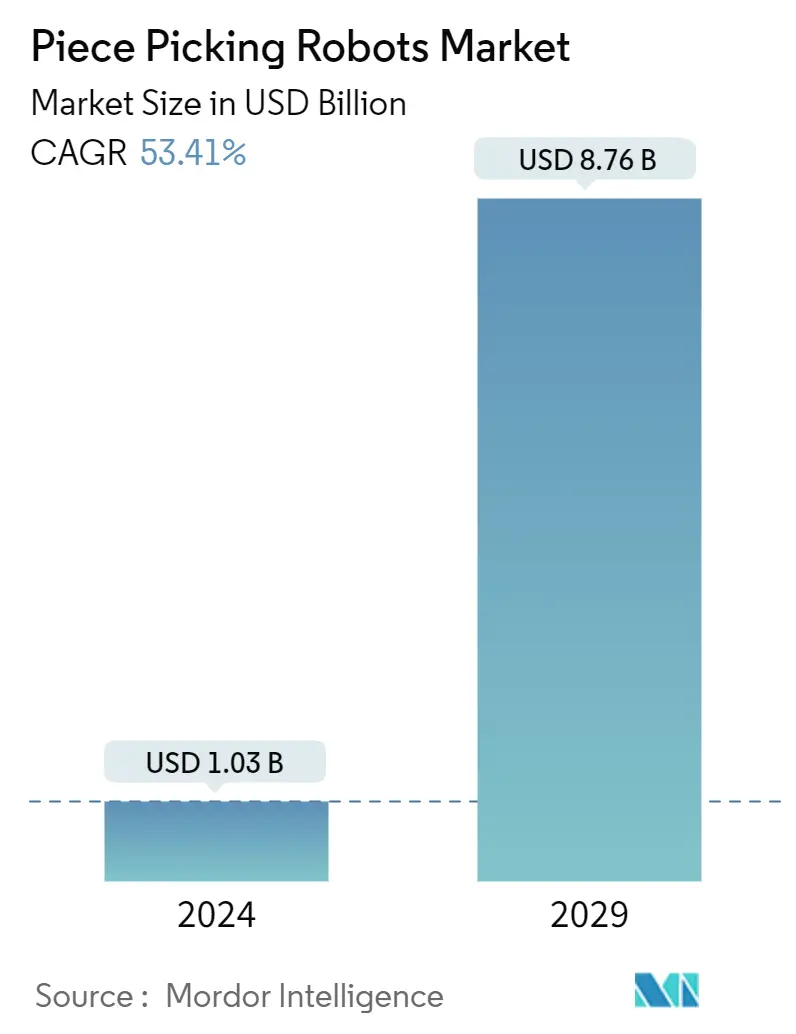Market Size of Piece Picking Robots Industry

| Study Period | 2019 - 2029 |
| Market Size (2024) | USD 1.03 Billion |
| Market Size (2029) | USD 8.76 Billion |
| CAGR (2024 - 2029) | 53.41 % |
| Fastest Growing Market | Asia Pacific |
| Largest Market | North America |
Major Players
*Disclaimer: Major Players sorted in no particular order |
Piece Picking Robots Market Analysis
The Piece Picking Robots Market size is estimated at USD 1.03 billion in 2024, and is expected to reach USD 8.76 billion by 2029, growing at a CAGR of 53.41% during the forecast period (2024-2029).
The Piece Picking Robots Market size is estimated at USD 1.03 billion in 2024, and is expected to reach USD 8.76 billion by 2029, growing at a CAGR of 53.41% during the forecast period (2024-2029).
COVID-19 significantly increased the sales of automated solutions, as well as the logistics requirements. Though the supply chain has been disrupted due to the lockdown, the industry has grown significantly. Warehouse order pickups are considered the most time-consuming part of the supply chain, with picking robots promising to shorten it. Mobile piece pickers, thus, can replace the number of hours that workers spend moving around the warehouse.
- According to inVia Robotics Inc., the time workers spend walking from location to location throughout the warehouse accounts for about 50% of the total pick time and represents more than 50% of all operational costs. Additionally, finding and retaining staff in today's tight labor market is challenging, often resulting in a repetitive and expensive cycle of hiring and training temporary workers. All these determinants, on a cumulative basis, are fuelling market growth.
- There are thousands of robots installed worldwide today that did not exist in this segment just five years ago. Consumer behavior is driving companies to address the demand for the personalization of both products and delivery. More and more companies are realizing the numerous advantages robotics provides their businesses. That list ranges from faster, more accurate picking to minimized labor requirements. Both the labor shortage and a lack of interest in working in traditional warehouse settings play to the value of piece-picking robots.
- Notably, in the manufacturing sector, collaborative as well as mobile robots address the demand for flexible material handling, the need for robots to be able to operate on large structures, and the requirement for rapid reconfiguration of work areas. Moreover, two roadmaps provide predictions for future mobile robot systems. For instance, the material handling institute expects new capabilities in autonomous control, artificial intelligence, and robotics, along with motion- and gesture-sensitive technologies that could lead to material handling systems in which humans, machines, and computers interact freely and effectively in completely new ways. The institute further predicts that it is expected that economical, high-speed automation for loading and unloading trucks should be available, both at the carton and pallet level, by 2025.
- Secondly, for piece-picking mobile robots used in manufacturing, a recent roadmap for US robotics predicts that autonomous vehicles will be capable of driving in any environment in which humans can drive and, furthermore, be safer and more predictable than a human driver by 2030. Vehicles will be able to learn on their own how to drive in previously unseen scenarios.
- The rising need for manufacturing and logistics companies to meet consumer demands for greater choice and faster delivery, against a backdrop of a shrinking labor pool, is leading businesses to look for new ways of automating their operations through the use of piece-picking robots. They are being adopted in increasing numbers in industrial applications as companies look for ways both to deploy their existing workforces more effectively and maximize the productivity and efficiency of their operations. For instance, in April 2022, FedEx, iHerb, and many other companies turned to piece-picking robotic systems to solve their fulfillment challenges.
- According to the Bank of America, by 2025, 45% of all manufacturing will be performed by robotic technology. Following this trend, large firms, such as Raymond Limited (an Indian textile major) and Foxconn Technology (a China-based supplier for large technology manufacturers like Samsung), have replaced (or plan to replace) 10,000 and 60,000 workers, respectively, by incorporating automated technology into their factories. Hence increasing investment in automation drives the market.
- Moreover, the rise in the number of robots in industrial areas will drive the studied market growth. According to IFR, approximately 4,35,000 industrial robots were expected to be shipped worldwide in 2021. Asia/Australia had the most units installed, with an estimated 3,06,000 in 2021. Industrial robot installations in Asia/Australia are expected to reach 370,000 units by 2024.
Piece Picking Robots Industry Segmentation
Piece-picking robots are competent in helping workers by eliminating the necessity for labor to be devoted to repetitive and critical tasks. These software-driven, hardware-enabled solutions handle the core task of picking and placing individual items as part of a wide range of workflows and processes. Piece-picking robots improve performance and efficiency in e-commerce order fulfillment and intralogistics.
The piece picking robots market is segmented by type of robot (collaborative, mobile), end-user vertical (pharmaceutical, retail/warehousing/distribution centers/logistics centers, other end user applications), and geography (North America, Europe, Asia Pacific, Rest of the World).
| By Type of Robot | |
| Collaborative | |
| Mobile and others |
| By End User Application | |
| Pharmaceutical | |
| Retail/Warehousing/Distribution Centers/Logistics Centers | |
| Other End User Applications |
| By Geography | |
| North America | |
| Europe | |
| Asia Pacific | |
| Rest of the World |
Piece Picking Robots Market Size Summary
The piece picking robots market is experiencing rapid expansion, driven by the increasing demand for automation in manufacturing and logistics sectors. This growth is largely attributed to the need for faster and more efficient warehouse operations, as traditional methods are becoming less viable due to labor shortages and rising operational costs. The adoption of piece picking robots is seen as a solution to these challenges, offering benefits such as reduced pick times and minimized labor requirements. The market is characterized by the integration of advanced technologies like artificial intelligence and autonomous control, which are enhancing the capabilities of these robots. Companies are increasingly recognizing the advantages of robotics, leading to a significant rise in installations and investments in automated solutions.
The market landscape is highly competitive, with major players like Plus One Robotics Inc., Kindred Systems Inc., and Universal Robots A/S actively engaging in partnerships and acquisitions to strengthen their market position. Collaborative robots, or cobots, are gaining traction due to their ability to work alongside human workers, improving accuracy and reducing errors in tasks such as material handling and assembly. The declining costs of these robots are making them more accessible, further driving their adoption across various industries. The North American region, in particular, is witnessing substantial growth due to the increasing deployment of piece picking robots in warehouses and e-commerce fulfillment centers. As businesses continue to seek ways to enhance productivity and efficiency, the piece picking robots market is poised for significant growth in the coming years.
Piece Picking Robots Market Size - Table of Contents
-
1. MARKET INSIGHTS
-
1.1 Market Overview
-
1.2 Industry Attractiveness - Porters Five Forces Analysis
-
1.2.1 Bargaining Power of Suppliers
-
1.2.2 Bargaining Power of Buyers
-
1.2.3 Threat of New Entrants
-
1.2.4 Threat of Substitutes
-
1.2.5 Intensity of Competitive Rivalry
-
-
1.3 Industry Value Chain Analysis
-
1.4 Assessment of Impact of COVID-19 on the Automation Industry
-
1.5 Piece-picking Robot Software Technology and Evolution
-
-
2. MARKET SEGMENTATION
-
2.1 By Type of Robot
-
2.1.1 Collaborative
-
2.1.2 Mobile and others
-
-
2.2 By End User Application
-
2.2.1 Pharmaceutical
-
2.2.2 Retail/Warehousing/Distribution Centers/Logistics Centers
-
2.2.3 Other End User Applications
-
-
2.3 By Geography
-
2.3.1 North America
-
2.3.2 Europe
-
2.3.3 Asia Pacific
-
2.3.4 Rest of the World
-
-
Piece Picking Robots Market Size FAQs
How big is the Piece Picking Robots Market?
The Piece Picking Robots Market size is expected to reach USD 1.03 billion in 2024 and grow at a CAGR of 53.41% to reach USD 8.76 billion by 2029.
What is the current Piece Picking Robots Market size?
In 2024, the Piece Picking Robots Market size is expected to reach USD 1.03 billion.

